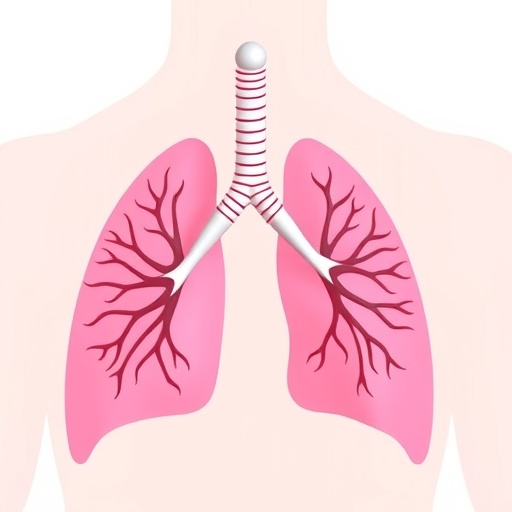Pulmonary arterial hypertension (PAH) is a progressive vascular disease characterized by elevated pressure in the pulmonary arteries, which ultimately leads to right heart failure and premature death. Despite advances in therapeutic approaches, PAH remains a condition with significant morbidity and mortality, often presenting at advanced stages. However, a pivotal new study published in the New England Journal of Medicine now reveals that early intervention with sotatercept, a novel biologic agent, in conjunction with standard therapies significantly halts disease progression when administered within the first year of diagnosis.
Sotatercept, marketed commercially as Winrevair, operates through an innovative mechanism by antagonizing activin signaling pathways, known to be aberrantly upregulated in PAH. Overactivation of activins promotes pathological thickening and remodeling of the pulmonary arterial walls, increasing vascular resistance and taxing cardiac output. By neutralizing these proteins, sotatercept aims to restore balance in pulmonary vascular homeostasis, thereby alleviating vascular obstruction and reducing right ventricular workload.
The findings stem from the HYPERION clinical trial, a rigorous double-blind, randomized, placebo-controlled phase 3 study led by Dr. Vallerie V. McLaughlin at the University of Michigan Medical School. Enrolling patients diagnosed with PAH within 12 months, the trial evaluated the efficacy of adding sotatercept to existing standard-of-care treatments. Remarkably, the cohort receiving sotatercept demonstrated a 76% reduction in risk associated with clinical deterioration, encompassing decreased exercise capacity, exacerbation of symptoms, and unscheduled hospital admissions when compared to placebo recipients.
One of the most compelling results was the rapid onset of therapeutic benefit, with improvements noted after merely three doses of the injectable drug. This early clinical response underscores sotatercept’s potent capacity to mitigate the underlying pathophysiological processes driving PAH progression, contrasting the delayed effects often observed with conventional vasodilatory or antiproliferative agents.
The trial’s profound positive outcomes were so evident that the study was prematurely halted to preserve ethical equipoise. Such early termination typically signifies a robust signal of efficacy, indicating that continued withholding of sotatercept from the control group could not be morally justified. This scenario arises rarely in clinical research, highlighting the transformative potential of this intervention for PAH patients.
While PAH historically manifests with insidious symptom progression, often diagnosed late, researchers stress that early pharmacological intervention can shift disease trajectories. Dr. McLaughlin emphasized that these findings advocate for prompt initiation of sotatercept soon after diagnosis, which may improve patients’ ability to attain and sustain a lower risk profile, thereby extending longevity and quality of life.
Previous landmark trials, including STELLAR and ZENITH, had demonstrated sotatercept’s efficacy in chronic, high-risk cases with longstanding PAH, where it enhanced exercise endurance and decreased mortality, transplant necessity, and hospitalization rates. However, HYPERION expands the evidence base by demonstrating that even early-stage patients diagnosed within a year benefit markedly, a critical distinction underscoring the importance of timing in therapeutic intervention.
Detailing safety outcomes, sotatercept’s most commonly observed side effects included epistaxis and telangiectasias, side effects consistent with its biological activity and manageable under clinical supervision. Notably, the incidence of hospitalization for PAH exacerbations was substantially lower in the treated group (under 2%) compared to placebo (8.8%), further corroborating its disease-modifying properties.
Mechanistically, sotatercept delivers its therapeutic effects via ligand traps that sequester members of the transforming growth factor-beta (TGF-β) superfamily, particularly activins and growth differentiation factors. By inhibiting these ligands, sotatercept antagonizes the SMAD2/3 signaling cascade implicated in vascular cell proliferation and remodeling, hallmarks of PAH pathology. This mechanism represents a paradigm shift, differing fundamentally from vasodilator-focused therapies by targeting upstream pathological drivers.
The study received funding and support from Merck Sharp & Dohme, a global biopharmaceutical company, ensuring adequate resources for comprehensive data collection and analysis. Complete author disclosures and methodological details are available alongside the published article in NEJM, affirming transparency and rigor in this landmark research.
In summary, the HYPERION trial stands as a groundbreaking milestone for PAH treatment, showcasing that biology-driven intervention with sotatercept, when applied early, can dramatically alter disease course and improve patient outcomes. As clinical guidelines evolve, the integration of this approach could redefine standard care protocols, highlighting the critical role of early diagnosis and prompt, mechanism-based therapy in managing pulmonary arterial hypertension.
Subject of Research: People
Article Title: Sotatercept for Pulmonary Arterial Hypertension within the First Year of Diagnosis
News Publication Date: 30-Sep-2025
Web References:
NEJM Article DOI: 10.1056/NEJMoa2508170
HYPERION Clinical Trial
STELLAR Trial
ZENITH Trial
References:
“Sotatercept for Pulmonary Arterial Hypertension within the First Year of Diagnosis,” New England Journal of Medicine. DOI: 10.1056/NEJMoa2508170
Keywords: Pulmonary hypertension, Hypertension, Heart failure, Cardiovascular disease
Tags: activin signaling pathway antagonismadvanced pulmonary hypertension symptomsearly intervention in PAHHYPERION clinical trial findingsmorbidity and mortality in PAHnovel therapies for vascular diseasespulmonary arterial hypertension treatmentpulmonary vascular homeostasis restorationreducing hospitalization rates in PAHright heart failure managementsotatercept biologic therapystandard therapies for pulmonary hypertension





